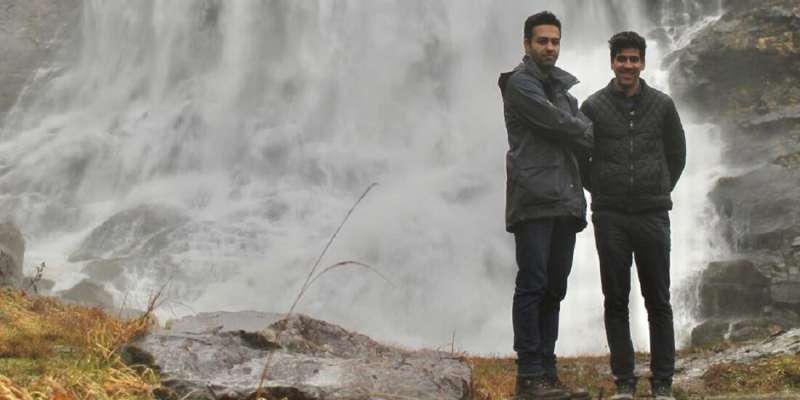Reza Argandeh (left) is a professor of computer science at the Western Norway University of Applied Sciences (HVL). He is standing next to Mojtaba Yousefi from HVL (right), who is also part of the team. Credit: Heather Arghandeh Paudler
Reza Arghandeh from the Western Norway University of Applied Sciences (HVL), Hossein Farahmand (NTNU) and their team are studying how hydropower producers can make better use of natural resources and flex with the market at any given time.
The researchers have developed concrete methods within artificial intelligence to calculate how producers should regulate the degree of filling in water reservoirs.
The leader of the research project on hydropower production is Hossen Farahmand at NTNU, a professor and head of the research group for electricity markets and energy system planning. The team also includes Mojtaba Yousefi from HVL and Jayaprakash Rajasekharan and Jinghao Wang, both from NTNU.
"If hydropower producers could make decisions that were just one percent better than before, it would amount to billions of kroner in difference and help to mitigate the energy crisis," says Arghandeh.
The future European power system—based primarily on renewable energy sources—will be much more weather dependent than the power system today. The two researchers believe that consumption patterns will also change.
All these factors contribute to creating uncertainty around the energy supply, causing decision-making to be far more complicated. The researchers will help to reduce this uncertainty, so that it will be easier to secure access to energy.
Completely dependent on electricity
Arghandeh has found a way to monitor meteorological data, hydrological data (how much water is supplied to the reservoirs) and topographical data (shape of the landscape) and interpret them with the help of advanced artificial intelligence.
Farahmand further combines the use of these AI models with data on the electricity market. Together, they have created a model that accounts for uncertainty in the market and in the weather and wind.
"Electricity isn't an ordinary product, but one that keeps our society afloat, almost like oxygen. That's why it's incredibly important to create affordable, reliable and sustainable access to this basic good," says Arghandeh.
Accurate and reliable inflow forecasting has always been a challenge in the production of hydropower.
Around Easter time, the reservoirs fill up. Then the snow melts on the mountain tops, and water begins to flow from the heights into the reservoirs, regulated waters and rivers around the country.
Between Easter and until winter returns around November, producers release water at regular intervals to supply the market.
They also need to make sure to have enough water left in the reservoirs to last through the winter season, when the supply dries up (or freezes).
Complicated math for water power
But when and how much water should be released? That depends on many different factors, including weather conditions, landscapes, rainfall, winter temperatures, the electricity market and the political situation in Europe.
Since the power system in Norway is connected to Europe, making good decisions becomes all the more difficult. This was powerfully demonstrated by the events that followed the Russian invasion of Ukraine. When Russia stopped the sale of gas to Europe as a result of European support for Ukraine, the effect on both energy access and energy prices was dramatic.
Calculations become extremely complicated with so many factors to take into account at once. The producers in the Norwegian hydropower industry use mathematics when they have to calculate how to regulate the water level in the reservoirs.
"We want to strengthen the classic calculation methods with methods from artificial intelligence. This way we can increase the speed of the calculations and obtain more precise answers," says Arghandeh.
Big ambitions for offshore wind
Hydropower production has its unpredictabilities, but this type of renewable energy also has major advantages. First and foremost, the water can be stored and produce the electricity when as it is needed, making it a very flexible and clean form of energy.
"At the same time, some boundaries need to be adhered to. A hydropower reservoir is limited in size, and the inflow of water is uneven," says Farahmand.
Hydropower has the potential to contribute to a secure supply of electricity to an even greater extent than today as methods from artificial intelligence help reduce the uncertainty surrounding decisions in the industry.
Norway is working to reduce the use of fossil fuel energy and become carbon neutral by 2050. An important step towards this goal is to introduce offshore wind. The plan is to build out 30 gigawatts of offshore wind capacity on the Norwegian continental shelf by 2040, an amount that equals the hydropower capacity in place today.
"The new green forms of energy like wind and solar are far less predictable than hydropower. The wind doesn't always blow and the sun doesn't always shine," says Farahmand.
"Since wind conditions change so quickly, we need models that can calculate how wind production affects the integrity of our energy supply hour by hour."
Collaborating with power producers
The researchers in the project have collaborated with power producers Lyse Produksjon AS and Østfold Energi. They are now testing the newly developed AI tools to see how they work when applied to their intended use. In the long term, they hope that the major players in the hydropower industry in Norway will adopt their methods.
"In transitioning to a society that relies far more on the sun and wind as energy sources, a sustainable hydropower supply will become far more important to us. We're really lucky in this country, which has such abundant opportunities to create clean energy," says Farahmand.
These clean energy sources "are a gift from nature. We need to make an effort to manage them as well as we possibly can," he says.
Provided by Norwegian University of Science and Technology
























